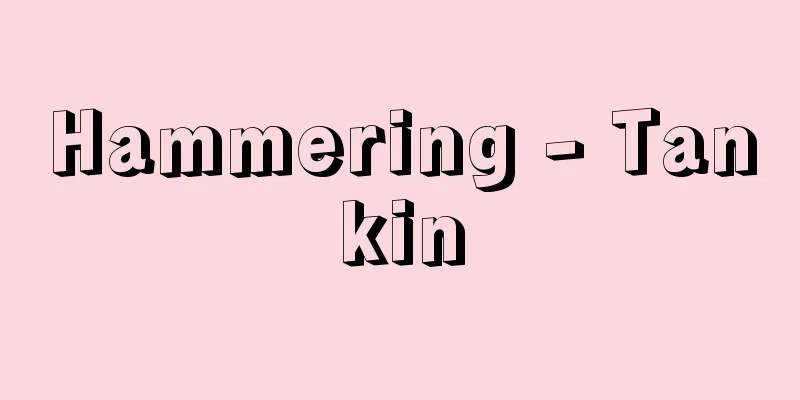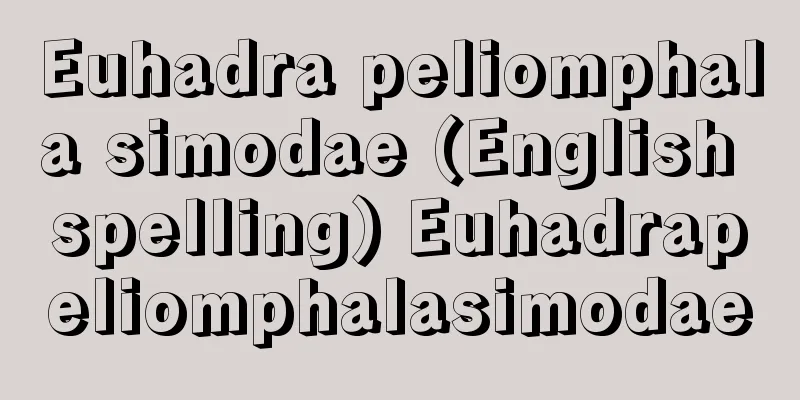Hammering - Tankin

|
A type of metalworking technique. It is a technique that uses the malleability and shrinkage of metal to create various vessels, and is also called forging, hammering, hammering, or tsuiki. Vessels are formed by beating and stretching a block of metal with a hammer or wooden mallet, hitting thin metal sheets from both sides, squeezing with a metal spatula , and bending. It is the oldest metal forming technique that has been used since the beginning of human use of metals. Examples can already be seen in Mesopotamia and Egypt from around 3000 BC, and in relics from the Yin Dynasty in China from around 1500 BC. In ancient times, gold, silver, and copper were the most common base metals, but copper alloys such as bronze, nickel-nickel, and brass, as well as iron and tin, were also commonly used, and in recent years platinum, aluminum, and stainless steel have also been used. A wide variety of examples of pottery have been seen since it was introduced to Japan from the continent during the Yayoi period along with mining and metallurgical techniques. However, as in other countries, the techniques can be broadly divided into three: hammering, sheet metal, and extrusion. (1) Tsuiki technique: This technique is used to hammer out a stretched metal sheet from both sides, then squeeze it to create a three-dimensional shape or to make a pattern stand out. It was already seen in swords, horse equipment, and accessories from the Kofun period, and was widely used in Buddhist altar items such as bowls, incense burners, trays, and bronze lanterns from the Nara period onwards. During the Muromachi period, this technique was continued in the production of armor accessories such as face masks and shin guards, but Yamada Soubi, who was active during the Meiji period, was particularly skilled in this technique, and was able to beautifully create complex shapes such as lions and doves from a single sheet of iron. (2) Sheet metal technique This is a technique for making three-dimensional objects by bending and soldering metal sheets. It is used in the production of gold and silver relic containers excavated from the central stone of the pagoda of Sofukuji Temple in Omi (Shiga Prefecture), which was founded in the 7th century, as well as in the production of sutra boxes and hanging lanterns. (3) Extrusion technique This technique involves placing a thin metal sheet on top of the original model and hammering it from above to transfer the shape of the original model. It has the advantage of being able to produce multiple pieces with the same pattern. This technique was most widely used in the Nara period for extrusion Buddhas, in which a thin copper plate was placed on top of a half-fleshed cast Buddha statue, hammered from above with a hammer to make it fit the mold, and then removed after all the details had been copied. The 1,000 Buddhas affixed to the inside of the Tamamushi Zushi at Horyu-ji Temple and the 1,000 Buddhas in the Hoke-Setsuso-zu at Hase-dera Temple were also made using this extrusion technique. Other examples are still on display at Toshodai-ji Temple and the Tokyo National Museum. Meanwhile, in the Shoso-in Repository there remain half-fleshed Buddha statues with crushed noses and deeply carved draperies on the robes that were used as prototypes for extrusion Buddhas. In addition, iron ornaments such as eagles, carp, and dragons that were popular during the Edo period are also special forged works, and swordsmithing can also be considered a type of forging technique in a broad sense. In modern times, mechanized molding using pressing and spinning has made mass production possible. [Harada Kazutoshi] [Reference item] | |Source: Shogakukan Encyclopedia Nipponica About Encyclopedia Nipponica Information | Legend |
|
金工技法の一種。金属の展延性・収縮性を利用してさまざまな器物をつくる技法で、鍛造(たんぞう)、打物(うちもの)、鎚金(ついきん)、鎚起(ついき)ともいう。金属塊を金槌(かなづち)や木槌で打ち延ばしたり、薄い板金を表裏から打ったり、金属のへらで絞ったり、折り曲げるなどして器物を成形するが、人類の金属利用の当初から行われた最古の金属成形技法である。すでに紀元前3000年ころのメソポタミアやエジプト、前1500年ころの中国殷(いん)代の遺品にその例がみられる。地金には古くは金・銀・銅が多いが、青銅・白銅・真鍮(しんちゅう)などの銅合金、鉄・錫(すず)もよく使われ、近年はプラチナ、アルミニウム、ステンレス鋼なども用いられる。 日本には弥生(やよい)時代に大陸から採鉱・冶金(やきん)技術とともに伝えられて以来、多種多様の遺例をみるが、その技法は、他の諸国と同じく、鎚起、板金(ばんきん)、押出(おしだし)の三つに大別される。 (1)鎚起技法 打ち延ばした板金を表裏から打ち出し、絞り縮めなどして立体的に成形したり文様を浮き出させる技法で、古墳時代の太刀(たち)、馬具、装身具などにすでにみられ、奈良時代以降は鉢、柄(え)香炉、盤、銅羅(どら)など仏具に多く用いられた。室町時代には甲冑(かっちゅう)の付属具である面頬(めんぼお)、臑当(すねあて)の製作に受け継がれたが、明治に活躍した山田宗美(そうび)はとくにこの技法に秀で、一枚の鉄板から獅子(しし)や鳩(はと)など複雑な造形をみごとにこなしている。 (2)板金技法 金属板を折り曲げたり、ろう付けなどして立体的なものをつくる技法で、古くは7世紀に創建された近江(おうみ)(滋賀県)の崇福寺の塔心礎から出土した金銀舎利容器の製作にみられるほか、経箱、釣灯籠(つりどうろう)などにも用いられている。 (3)押出技法 原型の上に薄い板金をのせ、上からたたいて原型の形を転写する技法で、同一文様を何枚もつくれる利点がある。これがもっとも活用されたのは奈良時代に盛行した押出し仏で、これは半肉鋳造の仏像形の上に薄い銅板をのせ、上から槌でたたいて型になじませ、細部までよく写し取ってから外したものである。法隆寺の玉虫厨子(ずし)の内側に貼(は)られた千体仏や、長谷(はせ)寺の法華説相図の千体仏もこの押出技法による。ほかに唐招提寺(とうしょうだいじ)や東京国立博物館にも現存している。一方、正倉院には、鼻がつぶれたり、衣文(えもん)の彫りの深い押出し仏の原型として使用された半肉仏像が残っている。 このほか、江戸時代に流行した鷲(わし)、鯉(こい)、竜などの鉄置物も特殊な鍛金作品で、刀鍛冶(かたなかじ)も広義には鍛金技法に属するといえる。近代以降は機械化による型打ち(プレス)やへら絞り(スピニング)による成形が行われ、大量生産が可能となった。 [原田一敏] [参照項目] | |出典 小学館 日本大百科全書(ニッポニカ)日本大百科全書(ニッポニカ)について 情報 | 凡例 |
<<: Tonguing (English spelling)
>>: Tankiri bean - Tankiri bean
Recommend
S(■1)1 - sn1
...An ionic reaction in which the reactive site o...
Jiroshin (English)
A Chinese folk god, said to be the second son of L...
Worcester
The county seat of Worcestershire, in the mid-west...
Tibetan - Chibettogo (English spelling)
It is the language of Tibetans living in Tibet, K...
Amorphous solid - Amorphous
In a crystal, atoms (or molecules) are arranged in...
Olive Colobus
… There is a great deal of variation among the sp...
Geissler burette
...A glass tube with a volumetric scale, with a g...
Al Rafiqah - Al Rafiqah
…Its Greek name was Nikēphorion, and later it was...
Priestly Source
…Both are considered to have been produced as off...
baccalarius
...On the other hand, the term bachelor originall...
Illyricum
An ancient Roman province in Illyria, located in t...
(R)Im Kŏ‐jŏng (Kkŏk‐jŏng)
?-1562 A leader of a popular revolt in the mid-Yi ...
Hermaphroditus
A hermaphrodite god in Greek mythology. A compound...
Fibrolane
…It is made by extracting proteins from soybeans,...
Nuchal septum - Nape
…The skin in this area is very thick, and hair gr...









